Introduction
Magnification loupes and lighting improve your visual acuity, enhance your diagnostic abilities, overall performance and the quality of your work. If you choose the correct products, and they are measured and made to ergonomic standards, they will also contribute to your long-term musculoskeletal health.
If you read through this guide, you will be able to assess your most important criteria in loupe and light selection. You will be able to tell if your representative is addressing the factors that have to be considered during the selection and ordering process.
Table of content
> Through-the-lens (TTL) vs. Flip-Up
> Diopters (reading glasses) vs. magnification power (loupes)
> Quality of optics, lens coatings and prescription considerations
> Prescriptions and contact lens considerations
> Frame considerations
> Width of field
> Depth of field
> Lighting
> Ergonomics, posture, eye strain and neck strain
> Magnification types, ranges and possibilities
> Satisfaction guarantees, adjustments or changes, and warranties
> Prices
Through-the-lens (TTL) vs. Flip-Up
TTL custom-made loupes provide maximum comfort, performance, and ease while working. Quality custom-made TTL loupes are manufactured specifically to your physical dimensions, magnification preference, types of procedures, prescription needs and most importantly, ergonomic needs. They are by far the most popular solution for all dental and medical professionals.
Flip-Up loupes are off-the-shelf products that can only be favored in very few situations. If you anticipate frequent prescription changes, you can lower costs and down-time by using flip-up loupes, as prescriptions can be changed by a local optician. However, there are many downsides. There is a more forward weight distribution, with more weight being placed on your nose. Resolution is lower, as there is an additional carrier lens. The field of view is reduced, as optics are further from the eye. There is also a need for frequent alignment adjustments from the flipping motion. Most users are not trained in adjusting the alignments for ergonomics, so this will also suffer.
If you wear contact lenses and anticipate frequent prescription changes, an alternative is to have your TTL loupes made for you to work while wearing your contact lenses.
In cases where loupes will be shared between 2 or more users, a non-prescription flip-up loupe can be shared amongst users. However, in addition to the above-mentioned inconveniences, the working distances will not be set up for each user. This can only be suggested where very occasional use will occur.
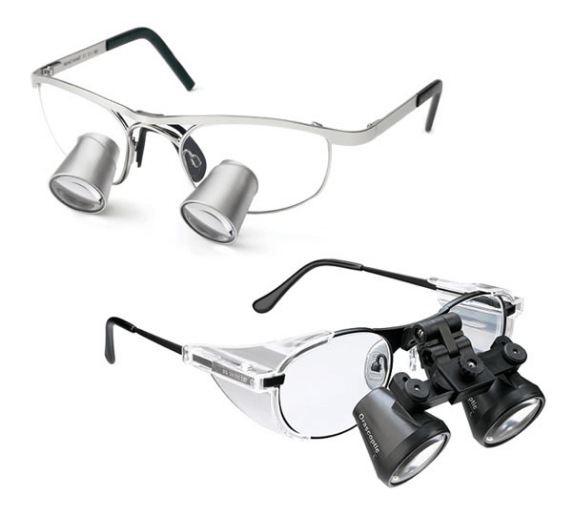
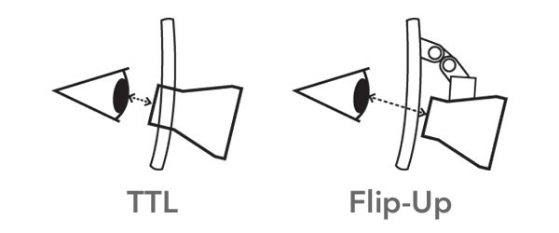
Diopters (reading glasses) vs. magnification power (loupes)
There is sometimes confusion between diopters and magnification power. The diopter is a measurement of refractive power and applies to a single corrective lens, such as what is found in reading glasses. Diopters provide a very limited magnification, depth of field and offer poor resolution.
For comparison, a prescription of +8.0 diopter, is approximately a magnification of 2.0x, nowhere near the magnification power of loupes.
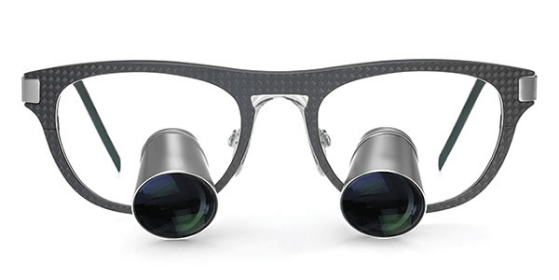
Quality of optics, lens coatings and prescription considerations
Optics
It is generally accepted that the highest quality optics are German, or possibly Japanese, however most manufacturers don’t state the country of origin of their optics on their web sites. Best quality optics will offer highest resolution, are free of optical and color distortion, and will be manufactured from very high index glass, to minimize both thickness and weight. If you are trying out different loupes, you can ask for a line chart to evaluate image distortion and chromatic aberrations.
Download our resolution grid to compare quality of different lens systems
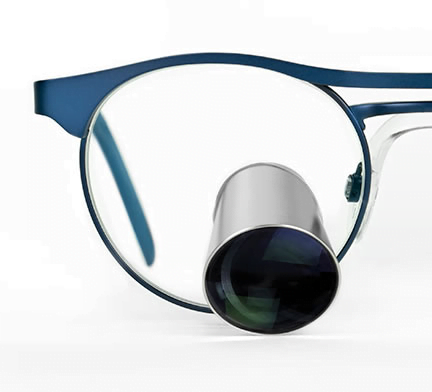
Button lense
The button (the lens that your eye looks into) of the ocular should be of large diameter and placed closest to the eye. A larger button and lens system have to be of quality high hi-index glass to minimize the weight of these larger optics. Smaller buttons are sometimes used since it less expensive to produce and will be lighter, but it won’t offer the same field of view, comfort and adaptability. It is possible to cut several buttons from a single prescription lens for insertion into the telescope, but there is only one (1) optimal button lens that can be cut at the sweet spot of every prescription lens. If a manufacturer makes several buttons from a single prescription lens, one of them will be ideal, but all the others will be somewhat inconsistent, will weigh more and show some distortion.
Prescriptions
If you are integrating a prescription correction into your TTL loupes, the quality of the prescription lenses not only affects the peripheral vision, but the vision through the telescopes, as a prescription lens is cut and used to make the button lens of the telescope. Quality, name-brand prescription lenses are of the highest quality for this purpose, but are more expensive. Any loupe manufacturer that uses them will state the manufacturer’s names in their printed materials, as it is proper justification for a higher cost.
Lens coatings
Prescriptions and contact lens considerations
It is imperative to have a recent eye test prior to ordering loupes. Small changes in vision are often not perceivable, but custom-made loupes are designed to work at exact distance ranges and the manufacturing specifications are based on corrected eye-sight. All prescription considerations should be integrated into the loupes. Your representative will advise you all these considerations, including use of peripheral vision, when communicating with others, writing tasks, viewing instruments, using computers, etc.
If you normally wear single vision prescription contact lenses, you must decide whether or not you want wear contact lenses when using your loupes. If you decide that you will wear them, your loupes will be made with this consideration. However, if on a given day you do not have your contact lenses, your loupes will not work correctly. Your representative can provide more details on this.
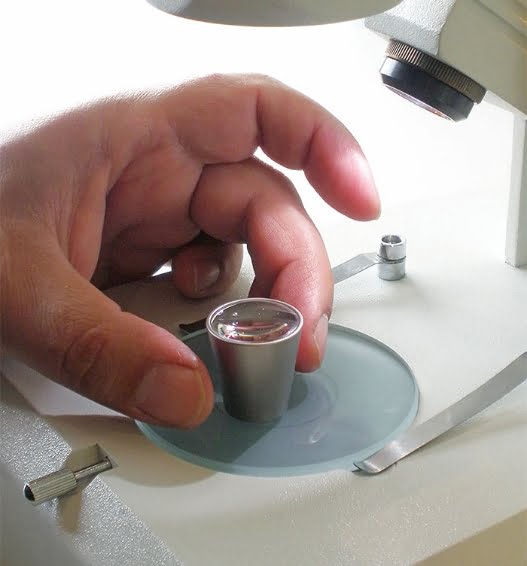
If you are under the age of 40, you naturally experience a larger depth of field, as your eyes have the ability to accommodate at different focal lengths. Starting at the age of 40, eyes lose the ability to focus at closer range. If you are myopic, this process may be delayed by a few years, but it is still necessary to have a recent eye exam, to ensure that loupes will operate at the manufactured working distance. As we get older, it becomes more important to use loupes that offer largest depths of field, or have adjustable working distances.
Frame considerations
In decreasing order of importance, considerations for frame selection should be: function and stability, low weight and balance, appealing design and cost. Look for a frame that is highly stable and adjustable. Stability is necessary to attain initial fine adjustments and maintain them over time. Some of these frames may be heavy and uncomfortable for extended wear, or may offer poor balance and weight distribution. Titanium or combinations of carbon fiber and titanium are highly desirable. It is possible to find fashionable frames that meet these requirements. You will feel the difference when wearing a lightweight, stable balanced frame (even more so with a LED light attached).
Opting for highest design appeal without consideration for the other factors will result in a disappointment. Plastic frames are low cost, lightweight and maybe often have an appealing design. They are the least stable, the least adjustable and will often break after only a year of use.
Generally, any fashion brand or sport frames that are not designed for loupes will not function as well as quality frames made specifically for loupes. Fashion frames offer quick appeal for the uneducated consumer.
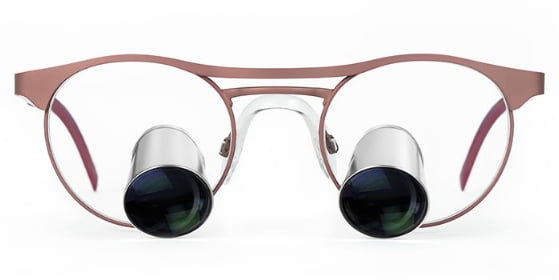
Width of field
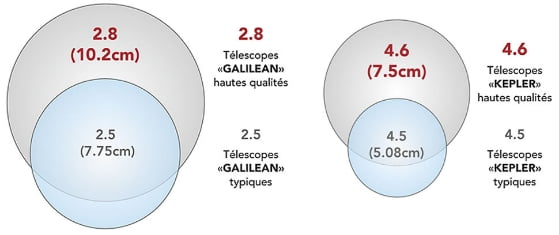
Depth of field
Depth of Field is the range of focus delivered by the loupe, or the distance that you can lean in or out, while the viewing object remains in focus. A large depth of field will allow you to maintain a balanced, ergonomic position, regardless of patient or procedure. Without this, you will experience poor positioning and additional physical strain.
Brand "X" offers depth-of-field of 37cm to 55cm

EX: Your working distance is 40cm
Most loupe designs don’t offer a custom working distance, but a series of 3-4 depths of fields. Unfortunately, you have to fit into the loupe, instead of the loupe fitting to you.
Brand "Y" offers depth-of-field of 40cm to 47cm

EX: Your working distance is 40cm
If this is compounded with a more economical loupe design that also limits depth-of-field, the problem is aggravated.
ExamVision offers custom depth of field

EX: Your working distance is 40cm
The center of your working distance is measured and used to build your loupes to this precise distance, which becomes the center of your depth-of-field.
Lighting
Additional illumination is mandatory with higher magnification and many experts consider it essential with any magnification. Due to the physics of magnification and light, since there is a smaller field width of light entering the eye, the field appears darker. To understand better, consider a microscope. Even though the field has adequate lighting with the naked eye, everything appears black under a microscope, unless a powerful light illuminates the extremely small field being magnified.
When operating with magnification loupes without additional LED lighting, the user’s pupils dilate due to reduced light, and this reduces the depth of field. With higher magnification, still less light enters the eyes, and the need for lighting increases. A simple demonstration of lighting products will confirm this.
A good LED light will produce and even beam of sufficient intensity in the desired concentration of color. Lights that are too bright will simply cause the eye rods to shut down and offer no additional benefit. Lights that are not bright enough will not be practical as magnification increases.
Light colors
LED Lighting colors vary in wavelength concentration, appearing either blue, white of red. There is no objective consensus on what is best, but opticians tend to favor colors away from blue, as ultra-violet light is the most damaging color for the eye. Some manufacturers may promote blue colored lighting, as at a given energy consumption it appears brighter. If you just look at specs, you believe you are getting more light output and a longer battery life. Often a whitish light is preferable. As all LED lights are producing some blue light, filter coatings are available that protect your eyes from long-term exposure.
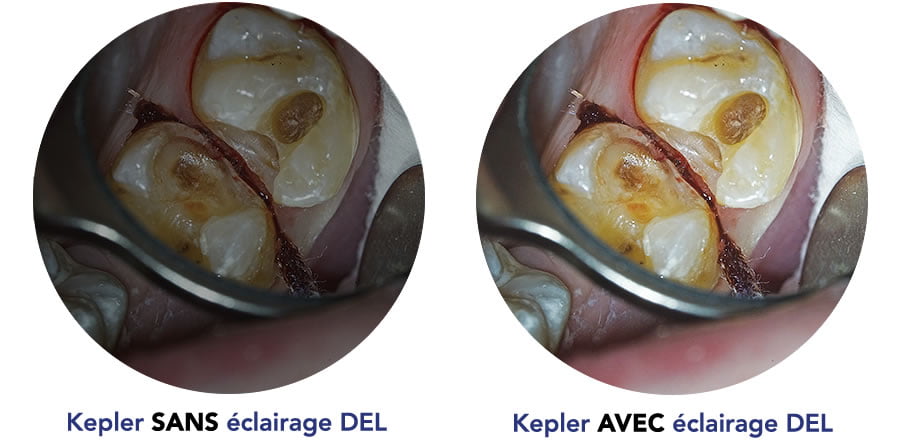
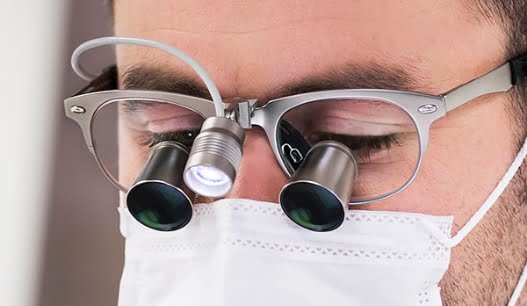
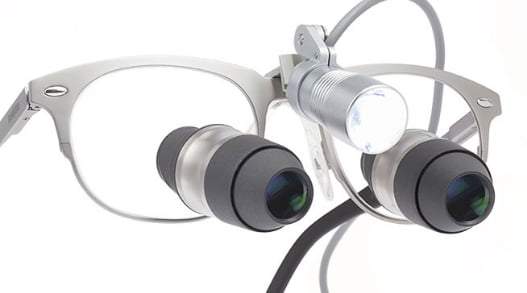
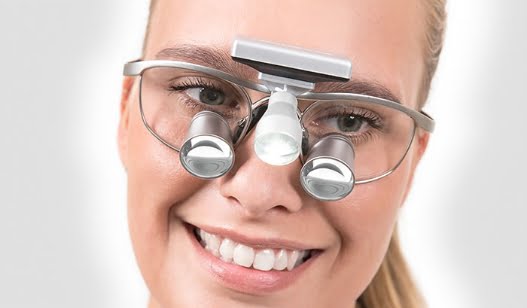
LED lighting must provide adequate, even lighting, at the desired working distance. The quality of the LED and the reflector that projects and focuses the light will impact the evenness of the light beam. Some LED lights incorporate an additional focus lens to ensure the most even, bright beam. Others offer quality reflectors, minimum weight and smaller size, since all these features sit on your nose. Again, higher quality and more expensive products make a difference. It’s relatively easy to test the color, evenness and brightness of a light at your chosen working distance by projecting the beam on a white paper.
Attachments
A few years ago, most lights were attached to headbands. Today most lights connect directly to your loupes. Consideration has to be given to overall weight, balance and comfort. Often, it is best to use the same brand for your loupes and your lighting, as they should be designed and balanced to work together. The connection between loupe and light should be solid; it should be easy to center the light on the magnified operating field without shifting. If you are using several brands of loupes and want to share a light between loupes, you may want to consider how easily and quickly the light can be connected and adjusted.
Battery systems
The popularity of LED lighting has resulted in several options for placing the battery pack. Each of these has their advantages and disadvantages. The traditional system is a cable between LED light and the control unit, which also houses the rechargeable battery. This is a tried and true system that allows for a long-lasting battery to be clipped somewhere on your clothes, where the weight of the battery pack is not an issue. The only limitation of these systems is the cable. They can be cumbersome and can tend to break over time. User-replaceable cables are now available on many products to minimize this inconvenience.
LED lighting systems offer several controls, allowing you to work at several intensities. Some allow for hands-free operation (on-off) to prevent cross-contamination. Some allow you to connect to the charger and continue to use the lighting while charging. It is important to note charging time and working time at the various intensities, to ensure that you can complete your daily tasks.
Cost of ownership
Ergonomics, posture, eye strain and neck strain
Dentists and hygienists have to deal with patient’s mouths that are too far away to perform quality work. In order to see properly without loupes, you have to lean in too close for maintenance of proper posture. Many factors have to be considered in making an ergonomic loupe.
There is a fine balance to be attained between your body positioning, chair height, working distances, magnification level, neck positioning, eye positioning and the patient’s oral cavity positioning – that will offer you a comfortable working position. The solution on here is not just slap in the steepest declination angle. This simply addresses neck strain. A trained representative can guide you though the proper steps, if they are working with a product that has the inherent ergonomic potential and the manufacturer that will build these ergonomic considerations into their product.
Specific ergonomic considerations that should be built into an ergonomic loupe include:
- Exact working distances ranges centered at your working distance – not preset working distance ranges
- Different magnification needs as ergonomic working distances change
- Types of procedures and level of detail required
- Measurements based on ideal neck tilt, eye tilt, pelvic tilt, elbow and forearm angulations, knee angulations
- Optimal oral cavity and patient positioning, stool height and chair height
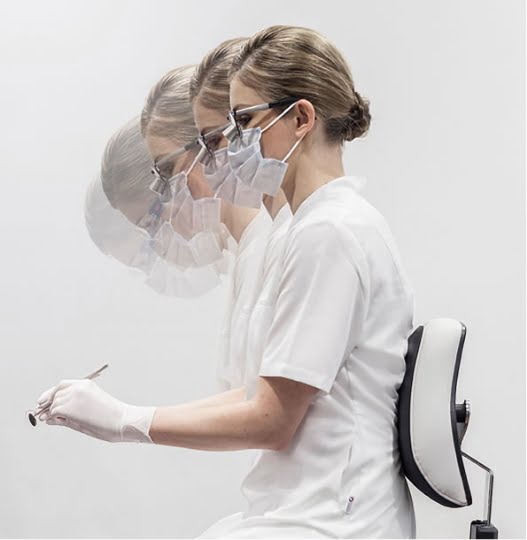
Magnification types, ranges and possibilities
Magnifications up to 2.8x
A Galilean design is lightweight and offers easier adaptability, with a sufficiently large width of field and superior depth of field. There are significant differences in the specifics of the lens systems of different brands that affect clarity, resolution, depth and width of field, reflections, etc.
Magnifications from 3.0x – 3.8x
Magnification loupes in this range can be manufactured using either Galilean or Kepler designs.
Traditionally, Galilean models have not offered sufficient performance to be used in higher magnifications. Today, premium Galilean products will offer sufficient resolution and clarity to be used for this magnification range. Restrictions of older or inferior products will include: higher weight, excessive color separation and limited widths of fields.
Because these quality Galilean loupes are easy to adapt to and offer bright images, professionals that are new to loupes are able to start immediately with these products. Dental hygienists commonly use 3.0x wide field magnification. Dental students are opting for various products in the 3.0x to 3.8x range.
Note that Galilean loupes all have a slight halo effect around the periphery of the visual field and will have a smaller width of field compared to their Kepler equivalent.
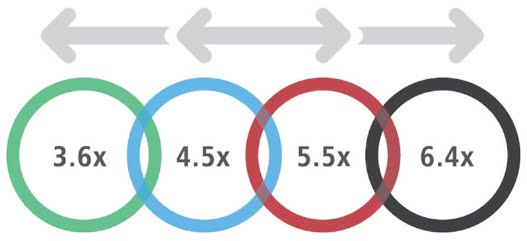
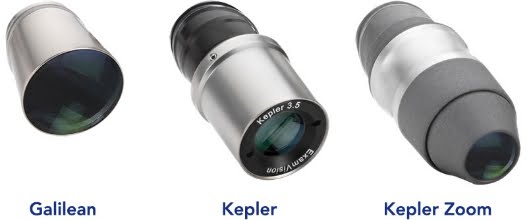
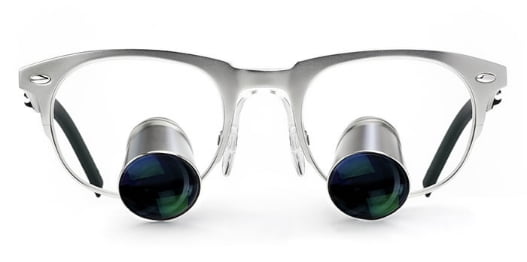
Higher magnification 3.5x - 6.4x
Kepler magnifications provide higher magnification possibilities with larger fields of view. These loupes are also known as Keplerian, prisms, or expanded field loupes, and they are the popular standard for higher magnifications (3.5x and up).
Traditional Kepler products have long, heavy barrels that place a lot of weight directly on the nose. They offer smaller widths of field and a darker image. Less light passes through these lens systems, when compared to more advanced Kepler products. They are prone to shadowing, due to misalignment between the eye and the object.
A high quality advanced Kepler loupe will use a very high index, expensive, lightweight glass lens system. It will offer a superior width-of-field and the ability to do fine focus adjustments. Since the depth of field of Kepler loupes is reduced as magnification increases, this is a very important feature. They will feature shorter barrels for less weight. Quality Kepler magnification offers a clear edge-to-edge images, unlike Galilean loupes that have a slight halo around the periphery.
Due to the investment in quality Kepler loupes, it is most important to work with a provider that can ensure proper, exact performance and ergonomic measurements. Due to the precision of the loupe, it is also very likely that some post-sales service is necessary to provide initial fine adjustments, as well as occasional frame adjustments over time.
Recent innovations
Two new innovations have been developed that change the paradigm of high-power magnification. It is now possible to achieve magnification in the 5.5x to 6.4x range, while maintaining a large field of view. Another exciting technology is the ability to combine multiple, high magnification levels into a single loupe. This allows you to have the equivalent of multiple high-power loupes in a single product.
Satisfaction guarantees, adjustments or changes, and warranties
In some cases, a loupe and light purchase is service-intensive due to the high number of factors that go into custom-making loupes. It is important to deal with someone that can service your needs post-purchase. Users will be wearing loupes for extended periods and may sometimes discover that they need changes in working distances, adjustments to the frames to realign the oculars, frame corrections, and many other local services.

Prices
With all the considerations that go into custom-manufacturing professional magnification loupes and lighting systems, there are obviously big disparities in prices. These prices vary with the decisions that the manufacturers make in determining what quality of components will be used.
Conclusion
Modern operating techniques require precision and the eyes are our instruments that deliver all the necessary information to the brain. Today’s technology makes it possible to provide very high levels of magnification and lighting to comfortably provide significantly more precise procedures. These products are essential for the maintenance of long-term musculoskeletal health.
